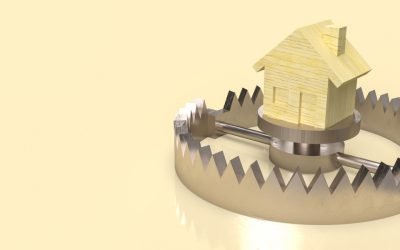Buying a property is an exciting time and when you find the right one you’ll want to rush to complete the deal. Discovering minor issues, such as peeling wallpaper, are unlikely to stop you from going ahead, but what about potentially huge issues such as subsidence? Should you buy a house with a history of subsidence?
You should buy a house with a history of subsidence only if the seller has established the structural issue has been correctly dealt with. If subsidence is a current issue, a full structural survey will be required before you make a final purchase decision.
If the historic issue has been addressed you should have nothing to worry about moving forward. If it’s an ongoing issue, you’ll need to be prepared to have the problem addressed sooner rather than later, to avoid costly repair work.
Property transactions operate under the principle of caveat emptor (buyer beware), putting the onus squarely on the buyer to discover information and defects with the building or land.
“It is up to the buyer to uncover these issues before signing their contract, or else take full responsibility for attending to urgent faults upon taking ownership,” warns Alan Rance, an experienced building surveyor in Bedfordshire.
What is Subsidence?
Subsidence occurs when the ground beneath your home begins to sink or move. It can happen gradually over many years, or suddenly in just a few days.
The cause could be anything from poor drainage, to heavy rainfall, to underground water movement. In some cases, subsidence may be caused by natural geological processes, such as tectonic plate movements. In others, it may be man-made, such as mining activities.
A subsided area can affect any part of your home, including foundations, walls, floors, ceilings, windows and doors. The most common areas affected include:
• Basements – This includes basement walls, floor slabs and foundation footings.
• Floors – This includes subfloor joists, beams, rafters and roof trusses.
• Walls – This includes exterior walls, interior partitions and internal framing members.
• Windows and Doors – This includes window frames, door jambs, sills and thresholds.
How do I know if a house is at risk of subsidence?
Buying a new home can be an exciting and daunting experience. In addition to the major financial commitment you are about to embark upon, you need to make sure that the property you are buying is in good condition.
House buyers are highly advised to have an independent home survey carried out prior to purchase, so that serious issues such as damp, timber defects and subsidence can be identified.
Of the three, subsidence is most likely to strike fear into the hearts of prospective buyers due to the damage it can cause and the cost to put right.
The good news is that subsidence doesn’t have to be a deal-breaker, especially if the occurrence is historic.
Since time immemorial, the land beneath our buildings has never been as rock-solid as we perhaps would like.
Take a pragmatic approach to understanding the nature of the problem and how to deal with it, and take specialist advice from your surveyor to inform your decision-making about your property purchase.
If you are considering buying a house with a history of subsidence, your first task is to find out as much as you can about the current condition of the problem.
- If the property has suffered from subsidence in the past, the seller should be able to provide all the necessary paperwork to show where structural movement occurred and how it was dealt with successfully at the time. He should also be able to produce a Certificate of Structural Adequacy. Your building survey will confirm that there is no ongoing movement.
- If subsidence is a current issue, a full structural survey will establish the severity of the issue and advise on what remedial action is required to deal with the problem.
In the first situation, the historic problem has been dealt with and isn’t an issue you need to concern yourself with.
In the second situation, your surveyor should also be able to help you draw up costings for any monitoring, underpinning and redecorating works, which you can use as a negotiating tool to reduce the sale price accordingly.
Can you get a mortgage if a house is at risk of subsidence?
You can expect any mortgage company to prick up their ears when the word ‘subsidence’ is mentioned. It is also important to be aware that buildings with current subsidence will be un-mortgageable, so if you have your heart set on a property that has ongoing issues, you will have to proceed as a cash buyer.
There is no good reason why a lender can’t offer a mortgage for an underpinned property as long as the survey confirms that the work has been carried out to a good standard and that there are no current problems. These days, most mainstream mortgage lenders will accept properties that have had subsidence issues that have been fully resolved, especially if no further movement has been detected for 10+ years. You shouldn’t need to seek out special mortgage lenders for properties with an old subsidence history.
Can you get home insurance if a house is at risk of subsidence?
Subsidence is usually covered under your building insurance. Properties with a known history of subsidence or heave can be harder to insure, and you may have to go to a specialist insurance provider to take out cover for properties that are known to be suffering from structural movement. Many standard home insurers will either refuse cover for a property that has ever been underpinned, or charge higher than average premiums, and higher excess for subsidence claims, to cover the additional risk.
That said, it always pays to shop around. AXA, for instance, only requires buildings to be subsidence free for 10 years for their standard building insurance.
Can you sell a house at risk of subsidence?
Selling the house may be the last thing on your mind when you are in the middle of a home purchase, but it’s important to be thinking long term.
It’s a good idea to put yourself in the shoes of a potential buyer and see how well a property with a history of subsidence presents.
Other people may be more cautious than you are with issues such as subsidence, which may make the property harder to sell.
Your best bet is to ensure you have all necessary documentation to reassure a future buyer, and to be diligent with your home and garden maintenance to reduce any further risk of structural movement.
Sources
https://www.pettyson.co.uk/about-us/our-blog/528-subsidence-guide
https://www.onlinemortgageadvisor.co.uk/property-types/buying-house-with-subsidence/
https://www.axa.co.uk/home-insurance/
https://www.homeprotect.co.uk/subsidence-insurance/how-to-prevent-subsidence
- Rent-to-Rent Schemes: Hidden Dangers Lurk - July 6, 2024
- How to Sell Your House Fast in Kent - July 5, 2024
- 7 Tips to Sell Your House Fast - July 4, 2024


